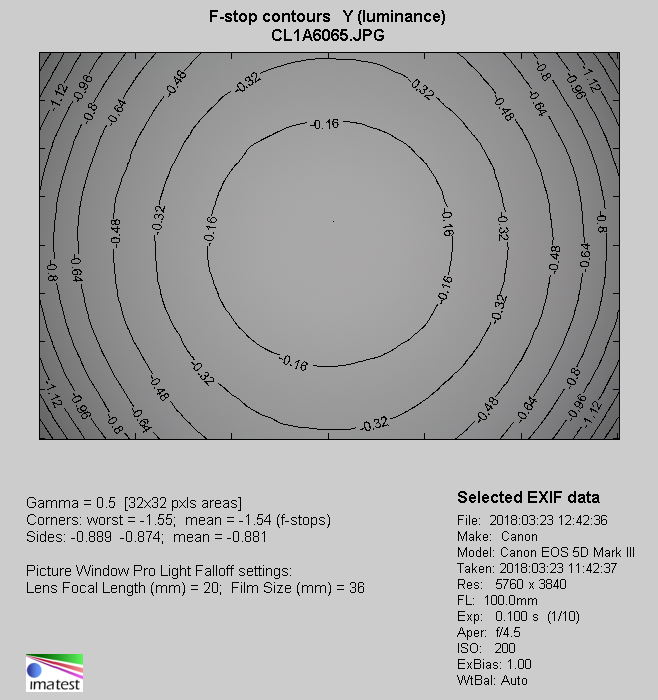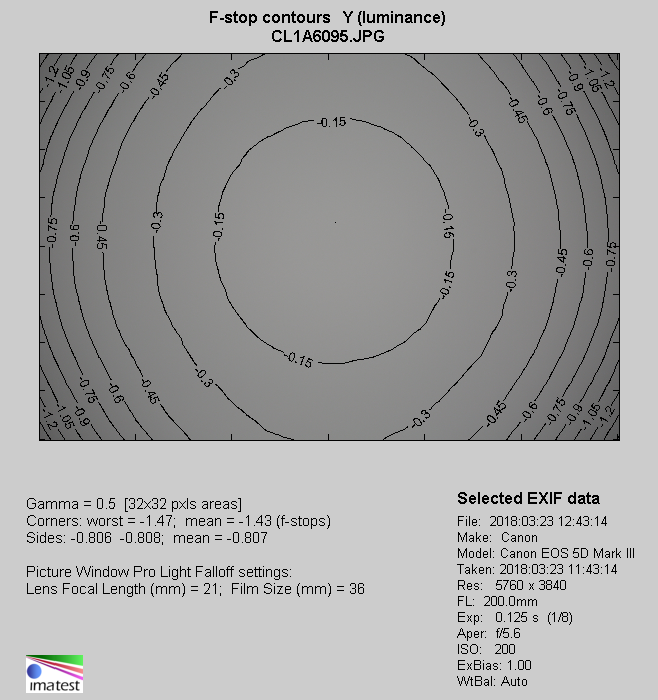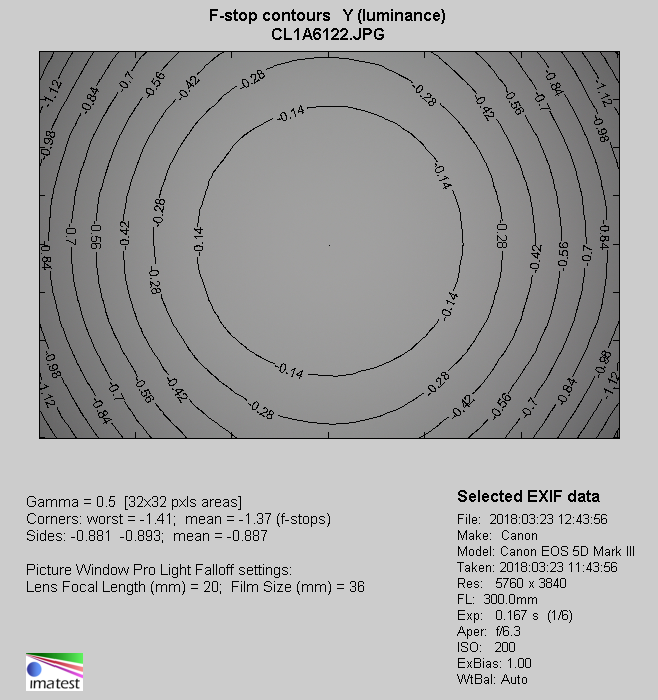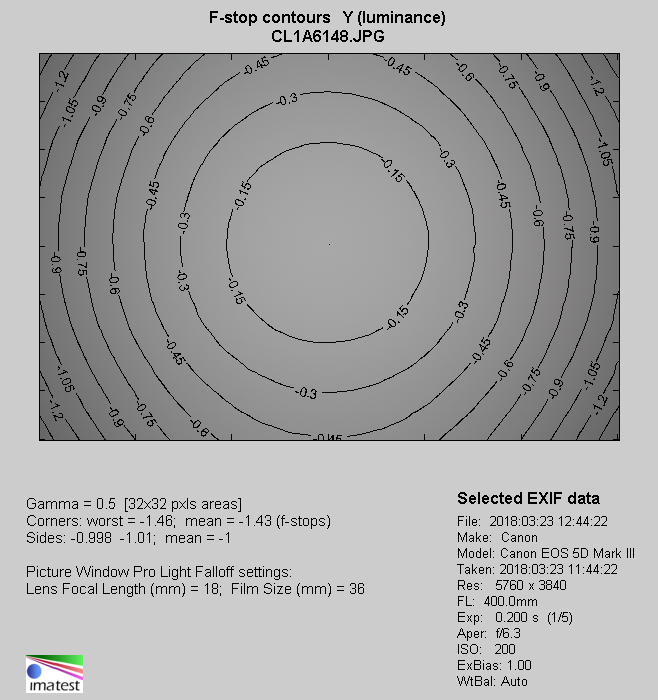Tamron 100-400 mm f/4.5-6.3 Di VC USD
8. Vignetting
| Canon 50D, 100 mm, f/4.5 | Canon 50D, 100 mm, f/5.6 |

|

|
| Canon 50D, 200 mm, f/5.6 | Canon 50D, 200 mm, f/8.0 |

|

|
| Canon 50D, 300 mm, f/6.3 | Canon 50D, 300 mm, f/8.0 |

|

|
| Canon 50D, 400 mm, f/6.3 | Canon 50D, 400 mm, f/8.0 |

|

|
At the 100 mm focal length the vignetting level is low even at the maximum relative aperture, reaching just 19% (−0.61 EV). It decreases to 13% (−0.41 EV) on stopping down the aperture to f/5.6 and becomes practically imperceptible (6% and −0.18 EV) by f/8.0.
Please Support UsIf you enjoy our reviews and articles, and you want us to continue our work please, support our website by donating through PayPal. The funds are going to be used for paying our editorial team, renting servers, and equipping our testing studio; only that way we will be able to continue providing you interesting content for free. |
- - - - - - - - - - - - - - - - - - - - - - - - - - - - - - - - - - - - - - - - - - - - - - - -
Even better situation can be observed at 200 mm where brightness loss in frame corners by f/5.6 is just 16% (−0.51 EV); then it decreases to 6% (−0.18 EV) on stopping down to f/8.0.
Similar results you see at 300 mm. In that case, at the maximum relative aperture, which is f/6.3 at that point, you get a vignetting level of 18% (−0.59 EV); then it decreases to 7% (−0.20 EV), on stopping down the aperture to f/8.0.
The biggest chances to notice vignetting you get at the 400 mm focal length. At the maximum relative aperture its level is 23% (−0.76 EV) and then it drops to 7% (−0.22 EV), an imperceptible value, on stopping down the lens to f/8.0.
Now let’s see how the lens performs in this category on full frame of the Canon EOS 5D Mark III.
| Canon 5D III, 100 mm, f/4.5 | Canon 5D III, 100 mm, f/5.6 |

|

|
| Canon 5D III, 200 mm, f/5.6 | Canon 5D III, 200 mm, f/8.0 |

|

|
| Canon 5D III, 300 mm, f/6.3 | Canon 5D III, 300 mm, f/8.0 |

|

|
| Canon 5D III, 400 mm, f/6.3 | Canon 5D III, 400 mm, f/8.0 |

|

|
The shortest focal length and its maximum relative aperture mean light fall-off amounting to as much as 41% (−1.54 EV). It is exactly the same value as in the case of the Sigma but that lens was a bit slower at that point so, overall, you can say the Tamron fares slightly better; if you stopped it down to the maximum aperture of the Sigma, its vignetting level would be lower.
Employing an aperture of f/5.6 means the decrease of vignetting to 29% (−0.99 EV). The Sigma performed a bit weaker with a result of 32%. The vignetting is still noticeable by f/8.0 and f/11.0 where it reaches, respectively, 20% (−0.66 EV) and 14% (−0.44 EV). Only after employing f/16.0 that aberration becomes imperceptible, dropping to 8% (−0.25 EV).
At the 200 mm focal length and by f/5.6 you have to take into account losing 39% of light (−1.43 EV) in the corners. That loss diminishes to 15% (−0.47 EV) on stopping down the aperture to f/8.0, and by f/11.0 it becomes practically imperceptible (6% and −0.18 EV).
Very similar results can be observed at 300 mm. At the maximum relative aperture the vignetting is 38% (−1.37 EV), and on stopping down the aperture to f/8.0 it decreases to a value of 19% (−0.61 EV); by f/11.0 it becomes imperceptible (5% and −0.15 EV).
There are no big changes at the maximum focal length if you compare it to 200 and 300 mm. By f/6.3 the vignetting is 39% (−1.43 EV) and it decreases to 20% (−0.65 EV) on stopping down the aperture to f/8.0. By f/11.0 that aberration becomes imperceptible and our official result was 5% (−0.15 EV).
Vignetting values at the longer end of the focal spectrum are practically identical with the performance of the Sigma C 100-400 mm and a bit worse than the results of faster brand name instruments.
| Canon 5D Mk III, 100 mm, f/4.5 |
 |
| Canon 5D Mk III, 200 mm, f/5.6 |
 |
| Canon 5D Mk III, 300 mm, f/6.3 |
 |
| Canon 5D Mk III, 400 mm, f/6.3 |
 |






